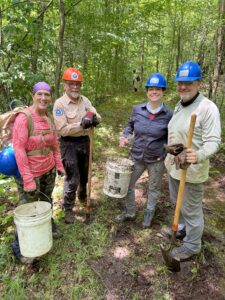 Inyo Nat’l Forest, CA (2006)
Inyo Nat’l Forest, CA (2006)“An annual ritual is underway – and I don’t mean the migration of Minnesota “snow birds” to southern Arizona. I’m talking about something quite different, which anyone who has led a group of Wilderness Volunteers into the backcountry can appreciate: trip planning. Every new trip is an adventure, and planning the trip is one of my favorite parts.
The overall structure of the project is set up by Dave Pacheco, WV’s Program Manager, who works with an agency contact at each trip destination. Dave gives us leaders “the big picture.” What are the dates and the location of the trip? What work will we do and where? Which goverment agency – the Park Service, Forest Service, BLM – manages the area? Will pack support be provided? Who led the project last year?
Now the fun begins for us leaders. Out come the maps, calipers to measure distances, a magnifying glass to read those tiny contour lines. How long is the hike from the trailhead to camp? How far is the work site from camp? What are the elevation gains and losses? How far to the nearest water source? What are we going to eat?
Phone calls and e-mails are exchanged between co-leaders. Who will cook? Who will be the agency contact? Who will write the publicity blurb? Who will contact the volunteers?
We must get commitments from the agency. They must provide plenty of tools, and the tools must be in good condition. We like to have at least one agency person with us to supervise the work project. We rely on the agency staff to answer many questions about the area. Where can we rendezvous on the night before the hike to base camp? What kind of weather should we expect? What interesting places and activities do they recommend for our free day? What kind of animals might we see (and which ones might want our food)?
An important part of trip planning is visualization. In your mind’s eye, place yourself at the trailhead, at the base camp, at the work site. What does it look like? How’s the weather? How are “the troops” holding up? Our crystal ball is pretty cloudy at this early stage, but it gets clearer as we learn more about the area, the project, and the volunteers. As we get more information, we refine the trip plan and our expectations.
Ultimately, we must remember that our volunteers are taking a week of precious vacation time to “give something back” in America’s wild lands – a week which could otherwise be spent lounging on the beach, relaxing at home, or sightseeing among the comforts of civilization. Above all else, we as leaders want to ensure that everyone’s experience in the backcountry is safe, meaningful, and fun. And the time to start planning for that is now.”



This comment has been removed by the author.
Well said. It takes a lot of pre-trip planning to enable us to have a great time.